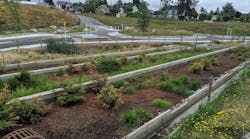Protecting the 700 Bridges of Steuben County
New York’s Steuben County is famous for just what you might guess: Steuben crystal. The maker of fine crystal animals, bowls, and candlesticks took its name from the county, and its parent company, Corning Inc., took its name from one of Steuben County’s largest cities, where it is headquartered. Corning’s factory still makes the Pyrex cookware that made it famous 80 years ago, but since then the old glass works has become a global giant, churning out such high-tech products as fiber-optic cable and the silica windows for NASA spacecraft. At 1,600 mi.2, Steuben County is one of the largest counties in New York, slightly smaller than the state of Delaware. But it is a largely rural place, latticed throughout with rivers and streams, with vineyards rolling among the Finger Lakes in the north and Amish villages nestled in the south. With few town-maintained bridges, the burden of taking care of the county’s infrastructure often falls upon the county Department of Public Works (DPW). The county has 678 mi. of road to look after, and chances are that each of those roads depends on a series of large and small bridges to get across the streams that crisscross the county. In all, the county maintains more than 700 of these bridges, about half of them smaller than 20 ft. long. “We’ve got a lot of water up here,” points out the DPW’s Kent Longacre. Troubled Water
Each year in the fall and winter, when the leaves are off the trees and won’t obscure the surveyors’ sightlines, the DPW inspects its bridges and selects a number of them to survey and improve. Using a Leica surveying gun that allows them to enter labels for features as they work, county surveyors measure the global positioning system coordinates of the banks of a river leading up to a bridge, including trees, buildings, and other landmarks. The surveyors download their raw data into a software program called Autodesk Survey, which creates a field book and captures the labels. With these data, DPW engineers can create a map of the stream with terrain features in a “real-world” coordinate system, adding local watershed details if necessary. “Land Desktop allows us to look at vertical profiles and sections of the river, which we can check against previous maps to see if the banks are eroding and need reinforcement,” explains Longacre, who is a computer-aided design specialist.A bridge structure might need repairs if it has deteriorated or is “skewed” improperly along the stream, channeling water the wrong way. In a downpour, fast-moving water could overwhelm such a bridge, degrading its banks or even undermining the road surface above. If the bridge needs to be realigned or repaired, DPW engineers plan the improvements using Autodesk Civil Design, sometimes designing new concrete beams and sending the drawings out to a beam supplier. “We’re one of the few counties in New York that does our own bridge design and construction in-house,” Longacre maintains. Dangerous CurvesIn addition to bridges, the Steuben DPW regularly selects parts of its road system for safety improvements: flattening out stretches of hilly or bumpy road, extending sightlines, and realigning dangerous curves. On a road where the surface has deteriorated or eroded over the years, causing it to dip up and down, surveyors take vertical measurements at intervals and then view the road’s topography. Using Land Desktop, engineers can create a digital terrain model of the road, looking at several profile cross-sections–“slices” of the road that they can compare with previous years–to see precisely where the road has deteriorated. Engineers can then calculate how much fill the DPW will need to make it level and safe again.CollaborationHaving a central repository for drawings in the DPW allows different engineers and drafters to collaborate, building on other people’s work. “We’re all networked, so one of us can call up the site plan from the database, rename it as a new file, and use it for something he has to do,” describes Longacre. “My colleagues here don’t have to design things from scratch on paper anymore; they can just work off my drawings, and vice versa.”Another benefit of in-house design is that the agency’s maps are more accessible. “For example, the other day the head of our road construction crews wanted to see a cross-section, so he just walked over to the designer and she pulled it,” Longacre relates. “If we had given the job to a consultant, we’d probably have to mark up a drawing and send it out, and it would take much longer.”“The bottom line is, if we can do highway designs ourselves, we save the taxpayers money,” says Longacre. “And we’re doing a pretty good job of handling it ourselves.”

